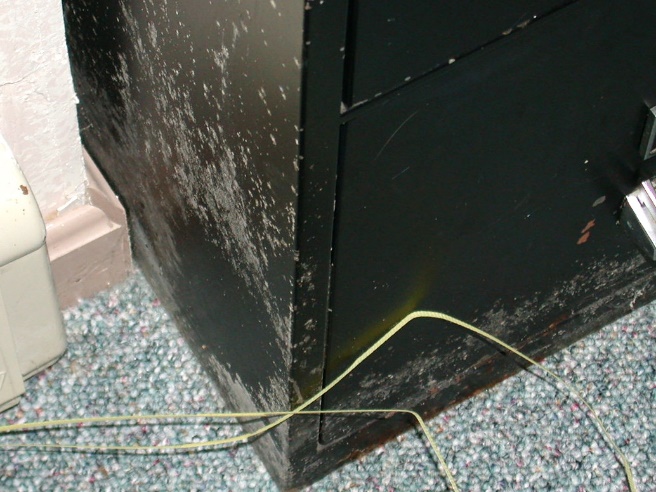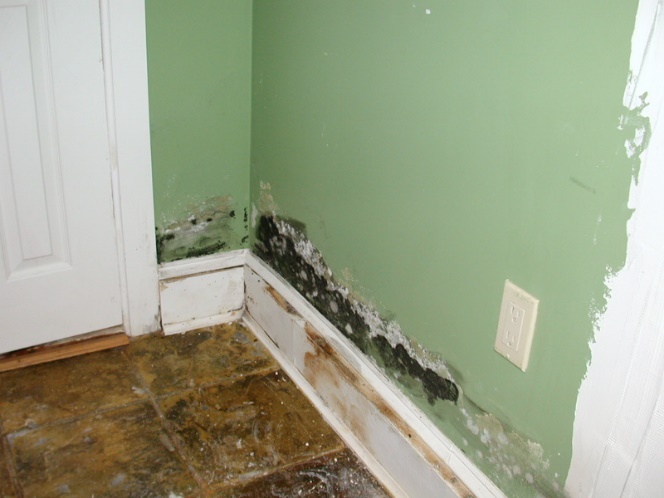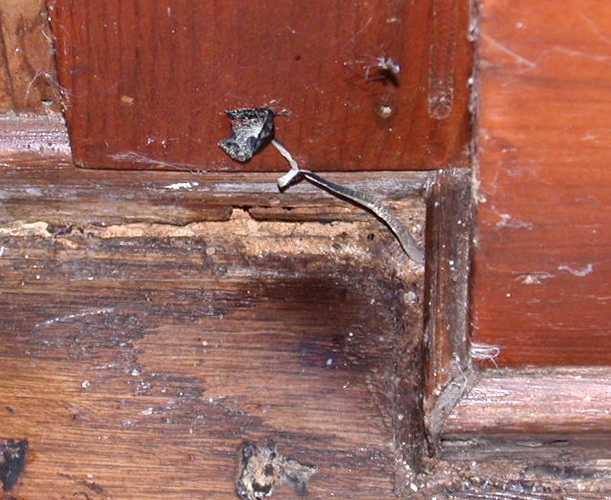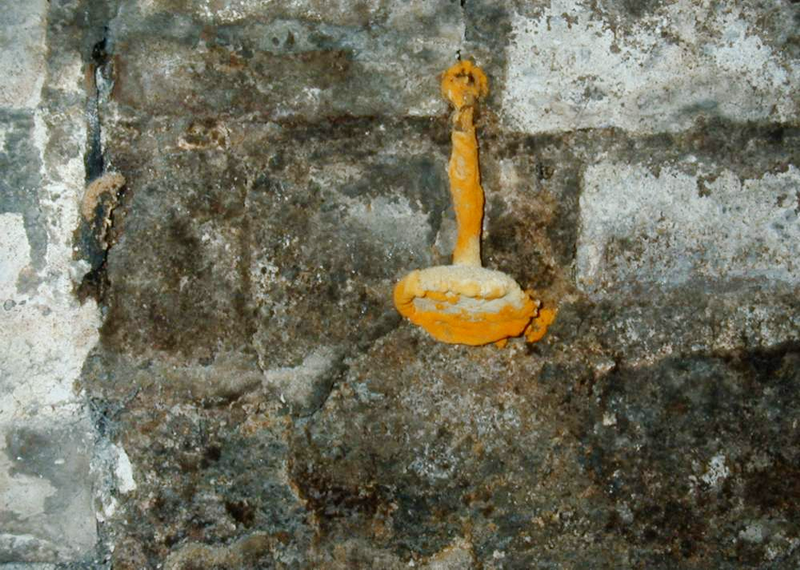IAQ IQ, Spring 2025
©2025 Jeffrey C. May
When it comes to fungal growth, there’s a big difference. In one case, a home inspector might recommend one kind of professional to do further investigation; in the other case, a home inspector might recommend a different professional altogether to do further “poking around.”
Microfungal Growth
Microfungi, or what are commonly called mold or mildew, grow along surfaces, digesting surface nutrients like skin scales, food bits, pet-dander particles, and even surface wood sugars. With very few exceptions, microfungi do not degrade wood. The spores and fungal fragments can, however, cause people who have mold sensitivities to cough and wheeze.
Allergenic Aspergillus and Penicillium molds grow in elevated relative humidity conditions, such as damp basements or on surfaces like kitchen cabinet kick spaces that are dusty and are then dampened by floor mopping or spilled foods. Cladosporium mold growth is also commonly found indoors. Two other molds found indoors are Stachybotrys (commonly called “toxic black mold) and Chaetomium, both of which require saturated conditions and are black in color. Stachybotrys will grow on cardboard boxes sitting on damp basement floors, or in wall cavities that have experienced or are experiencing long-time leaks.
Here are some photographs of some microfungal growth.

![F:\Documents\Mold photos misc\P1120296 Aspergillus on wall [sampled] Margolin.JPG](https://www.mayindoorair.com/wp-content/uploads/2025/04/f-documents-mold-photos-misc-p1120296-aspergillus.jpeg)


Where might you find microfungal growth in a home?
Below-grade:
- A dirt basement or crawlspace
- A crawlspace that is being vented to the exterior (all that moist air)
- In a basement with a shop (all that biodegradable dust – and when a basement isn’t being dehumidified)
- On surfaces in a finished basement that has not been consistently heated in the heating season or has not been air conditioned or dehumidified in the humid season (in New England, generally between mid-April and mid-October)
- On vinyl-coated insulating duct wrap on metal ducts
Above grade:
- On the lower foot or so of the wall or on the baseboard trim in an exterior closet above grade
- On kitchen cabinet kick spaces
- In sink cabinets that experienced leakage at some point
- On the inner and outer surfaces of door gaskets of a front-loading washing machine (are the washing machine and dryer included in the deal?)
- On the bottom foot or so of the interior of garage doors
- On radon piping exposed in a closet
- On the bottom of a toilet tank
In mechanical equipment:
- In an air handler with inadequate filtration
- In ducts, even in new construction. (Often builders operate heating and cooling systems during construction, and the ducts can fill with biodegradable dust.)
- In a mini-split. (Dark spots on the louvers are telltale signs of mold growth.)
Case Study: One couple had put down a hefty deposit for a newly constructed home at the edge of a posh golf course. The woman had mold allergies, so the couple was very specific about the filtration they wanted installed in the six air handlers in the hydro-air system. Whenever they went into the house to check on the progress of the construction, though, she experienced asthma symptoms. The construction crew had removed the filters from the air handlers because they “didn’t want the filters to get dirty.” (They were sawing wood in the basement: unfortunately, a common practice.) Needless to say, the air handling units and all the ducts were full of sawdust and mold growth. The couple insisted that the entire duct system be cleaned. The developer hired someone who did a shoddy job, so the couple withdrew from the deal. They got their deposit back, though, because the general contractor in charge of the construction had not met the deadline for completion of the work.
For people with allergies or asthma, I always recommend that during construction of a house that will have a duct system, heat and air conditioning must be supplied by portable units, and the HVAC equipment installed only when the construction is nearly completed. In addition, ducts should not be laying around on a basement floor, because they’ll contain biodegradable dust before they are even installed. And once they are installed, the supplies and returns should be sealed if the construction/renovation work is on-going.
Even though in Massachusetts home inspectors aren’t required to comment on indoor environmental conditions, if you detect a musty smell or see possible mold growth in a house, recommend further evaluation by an indoor air quality investigator, especially if your client has allergies or asthma. Your buyer client could also seek a remediation estimate that might help with price negotiations with the seller.
Macrofungal Growth
Macrofungi degrade wood and thus can, over time, potentially damage a home’s structural elements. Macrofungi produce fruiting bodies that we call mushrooms or toadstools. If you see mushrooms or toadstools or the hyphal mat (paper-like mat of a dried up mycelium), you can be sure that there are hyphae beneath the surface, digesting the wood structure.
Here are some photographs of macrofungal growth:




If you see mushrooms or mycelium like these on the inside or exterior of a home, sound an alarm and recommend further evaluation, either by a contractor or a structural engineer, depending on where the mushroom is located and how many mushrooms are present.
Case study: I worked with one client who saw a mushroom growing out of the floor at the base of a toilet. Not thinking anything of it, he just picked the mushroom and threw it out. I’ll bet you’ve already figured out the problem: the toilet seal was leaking, and there was extensive damage to the floor and subfloor at the toilet’s perimeter. There was even a puddle in the basement with sewer flies buzzing around!
Where might you find evidence of macrofungal growth?
At the exterior:
- On the northeast-facing exterior of a home
- On the exterior of a home located in front of a large body of water
- On the exterior of a home where there has been poor control of roof water
- On an area of the exterior that is splashed by irrigation water on a consistent basis
Below-grade:
- Inside a basement that has experienced chronic water intrusion, so building materials remained damp for an extended period of time
Don’t wait until that dreaded call from a former client who says, “We had to remove all the siding from that house that you inspected, and we found extensive damage in the sheathing due to fungal growth.” Give warnings up front and recommend further evaluation/research. Put it in writing. Then it will be up to your client to follow or not follow your advice.
The photographs in this articles are the property of May Indoor Air Investigations and can be used with permission. jeff@mayindoorair.com.
RESOURCE BOX
We have been producing newsletters for home inspectors since 2006 and for clients since 2013. If there is an indoor-environmental topic you are interested in, we may have produced a newsletter addressing the topic. Get in touch with us and we would be happy to look in our archives and send you a copy of that newsletter. In addition, many of our more recent newsletters are available on our site: www.mayindoorair.com. Go the “Library” page.
I continue to devote a complimentary half hour of my consulting time on the phone to people who are referred to me by their home inspectors. If you recommend that one of your clients call me, be sure to tell the person to give me your name. I am also happy to speak to any of you without charge if you have questions about indoor environmental issues that you think I might be able to answer. As many of you know, I used to be a home inspector, and I remain committed to the profession and maintain my memberships in the American Society of Home Inspectors and in ASHI’s New England Chapter.
Jeff May
May Indoor Air Investigations LLC
www.mayindoorair.com Tyngsborough, MA Jeff@mayindoorair.com
978-649-1055 (Office) 617-694-2510 (Cell)
